
How to use geofencing in your account-based marketing strategy
Geofencing is regarded as an instrument within regionally limited guerrilla marketing campaigns. What many marketing managers do not have on their radar: Even for account-based marketing, the approach increasingly turns out to be an ingenious move and another component to address the desired target group. We give tips on how marketing managers can effectively integrate geofencing into an overall account-based marketing strategy and use synergies.
As soon as you enter a busy sporting goods store, you will hear the notification tone in your pocket. A new email appears on your smartphone screen – randomly with special offers on football boots, tennis rackets and more from the store you’re in right now.
Most marketing managers think about this scenario first when they come into contact with the buzzword “geofencing”. By the way, the dream of many retailers has not really come true yet. But with the marketing trend Account-based Marketing (ABM), technology is experiencing its second spring – and could become one of the most important weapons in the fight for the desired target group for many marketing managers, especially in the B2B environment.
Geofencing in your ABM strategy
Account-based marketing (ABM) generally describes the targeted addressing of previously defined desired customers with individually coordinated messages. In digital B2B marketing, these companies are localized with the help of data collected either by themselves or by third-party providers.
A classic ABM strategy first requires that marketing and sales staff work together to create a list of companies they want to win as customers. In general, there are many ways to define accounts to target in ABM.
Thus, a pure clustering of companies according to characteristics such as size, number and type of contact persons or phase in the sales funnel is also possible. Alternatively, you can also select specific companies that you would like to address with your products or services.
Addressing target groups with the right channels
ABM offers a wide range of technical options using the potential leads in a campaign. Experience has shown that many agencies and marketing departments rely on a few selected channels such as Google Ads or Facebook. We recommends our award-winning 360-degree omnichannel approach in order to address target groups from several sides with the desired message.
Within the overall strategy, the desired positions of the companies can be addressed directly, for example via the detailed target group settings of LinkedIn or e-mails. Via an initially defined clustering of target groups, these can also be addressed via native advertising campaigns, for example via the publisher networks plista or Outbrain.
Like an ace in the hole, geofencing is often used in indirect targeting at a point where other measures are not effective. Advertisements can be limited to clearly defined locations such as the headquarters of the desired company.
Access the current location
But how do advertisers obtain the location data of the desired target group? Surely after downloading an app you have already received an automatic request whether it is allowed to access your current location.
Once you’ve agreed, the app can access your GPS data – whether the app is open or not. For example, on Google Maps, you need to agree to use the app at all.
Which marketing channels offer geofencing?
From Google Ads to Social Media to Native Advertising: Almost every marketing channel offers a certain form of geofencing. Most of the time, however, the targeting settings are rather “rough” in nature. This is useful if the campaign is limited to one language only or the rolls of a regional baker are to be advertised.
Currently, Google Ads and Facebook probably have the most accurate targeting possibilities. Both Google Ads and Facebook and Instagram can target not only cities, but even streets with a radius of 1 kilometer.
Possible uses of geofencing
As mentioned at the beginning, geofencing is mostly used in the B2C environment for local branches or certain locations. For example, push messages with special offers or discount codes can be sent to potential customers as soon as they enter the store.
In the same way, advertisements can also be displayed with a target-group-specific approach at marketing-relevant locations: For example, advertisements for football boots for users who are often on a football field.
In the B2B sector, these targeting lists are the focus of geofencing. Such lists often contain publicly accessible location addresses of the target companies. If you want to address the employees of the major automobile manufacturers with your advertising, you can use the targeting functions Google Ads and Facebook Ads to directly target the exact location of the company. In combination with other target group settings, the ads can be tailored even more precisely to specific groups of people.
Consulting for medium-sized companies
Would you like to find out whether geofencing and account-based marketing are interesting for your company and your industry in general? Please contact the ABM experts of Evernine Group, they will provide you with professional advice in a non-binding initial meeting.
Kathrin Drechsler, Chief Marketing Officer at Evernine Group, says about geofencing: “We are receiving more and more enquiries about account-based marketing from SMEs, but also from corporations – and we’re doing just fine! So far, we have had very good experience here, especially because we can keep the scattering losses extremely low. We recommend a holistic approach to account-based marketing. Depending on the industry, brand awareness and campaign theme, the measures work differently well. Geofencing via LinkedIn and Google Ads is certainly a clever option if you want to address larger corporations.”
The Evernine Group has received several awards for this unique campaign approach in the field of account-based marketing, including the Deutscher Pris für Onlinekommunikation (DPOK). You can find more information here.
Source Title Image: AdobeStock / Andrey Popov



